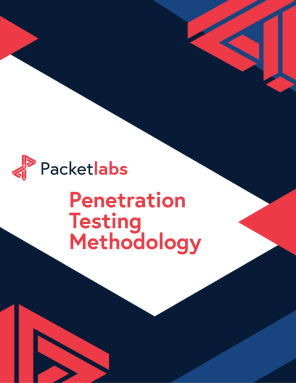The Comprehensive Guide to API Penetration Testing
- Overview
- This Guide Includes
- Who Will Benefit From This Guide
- What is API Penetration Testing?
- Why API Penetration Testing is Essential
- Benefits of API Pentesting Include:
- Packetlabs API Penetration Testing Methodology
- Our methodology includes:
- What Makes API Penetration Testing Different
- API Penetration Testing vs. Other Traditional Pentesting
- Regulatory and Compliance Alignment Via API Pentesting
- Why Choose Packetlabs
- Why clients choose Packetlabs:
- Next Steps
Would you like to learn more?
Download our Pentest Sourcing Guide to learn everything you need to know to successfully plan, scope, and execute your penetration testing projects.
Overview
As digital transformation accelerates, organizations are increasingly relying on Application Programming Interfaces (APIs) to connect systems, services, and users.
However, APIs (the very foundation of modern software ecosystems) are also among the most targeted attack surfaces today. APIs power mobile applications, cloud services, IoT devices, and third-party integrations, yet many are deployed with insufficient authentication, weak input validation, or poor access controls, leaving sensitive data and backend systems exposed.
Threat actors frequently exploit vulnerable APIs to bypass authentication, exfiltrate confidential data, perform account takeovers, or manipulate business logic. A single exposed endpoint can compromise entire networks, damage brand trust, and trigger severe compliance violations or class-action lawsuits.
In recent years, industry-wide disclosures and OWASP’s API Security Top 10 have underscored the growing need for specialized API security testing as part of a mature cybersecurity strategy.
This guide will help you understand what API Penetration Testing entails, why it’s distinct from traditional web or infrastructure testing, and how Packetlabs’ API Penetration Testing methodology ensures your applications and data are secure. You’ll also learn what to expect from an engagement and how our Continuous Pentesting enables faster remediation and collaboration.
This Guide Includes
A comprehensive overview of API Penetration Testing
Why API security is critical for digital resilience
The phases and methodologies behind an API penetration test
How API pentesting differs from other types of security assessments
How API testing supports regulatory and compliance initiatives
What to expect from a Packetlabs API Penetration Test engagement
The next steps for organizations looking to secure their APIs
Who Will Benefit From This Guide
This guide is designed for:
CISOs, CTOs, and IT leaders responsible for securing digital applications and integrations
Developers and DevOps teams deploying APIs in production environments
Security architects, engineers, and administrators
Managed Service Providers (MSPs) and SaaS vendors
Compliance officers and cyber insurance specialists seeking validated assurance
What is API Penetration Testing?
API Penetration Testing is a specialized assessment that evaluates the security of an organization’s APIs (whether they be internal, partner-facing, or public) to ensure they are resilient against real-world cyberattacks.
Unlike standard web application testing, API penetration testing focuses on endpoints, logic, authentication, and data flows, simulating how adversaries would exploit weaknesses to gain unauthorized access or manipulate business processes.
A comprehensive API penetration test provides:
Identification of vulnerabilities and insecure configurations across all exposed endpoints
Verification of authentication, authorization, and session management controls
Detailed insights into data exposure and privacy risks
Actionable remediation recommendations aligned to risk severity
Why API Penetration Testing is Essential
APIs are the digital connective tissue of modern organizations, linking cloud platforms, mobile apps, third-party vendors, and backend systems. But every exposed endpoint is a potential doorway for attackers.
Threat actors commonly exploit APIs to:
Enumerate users and extract sensitive data (e.g., PII, credentials, tokens)
Exploit weak authentication or authorization to escalate privileges
Abuse business logic or manipulate data integrity
Chain vulnerabilities across microservices for lateral movement
Regular API penetration testing ensures you identify and remediate these weaknesses before they’re discovered by attackers.
Benefits of API Pentesting Include:
Protecting sensitive data and backend systems
Reducing the risk of data breaches and account compromise
Validating API authentication, authorization, and encryption
Supporting compliance with OWASP API Top 10, ISO 27001, SOC 2, GDPR, HIPAA, and PCI DSS
Strengthening overall trust in digital products and third-party integrations
Packetlabs API Penetration Testing Methodology
Each Packetlabs engagement is tailored to your API architecture, technology stack, and risk tolerance.
Our tests are 100% manual, comprehensive, and conducted by certified ethical hackers who understand the complexities of REST, GraphQL, SOAP, and other modern API frameworks.
Our methodology includes:
Discovery and Enumeration
Mapping all accessible API endpoints (internal, partner, and public)
Identifying undocumented or shadow APIs that may bypass normal controls
Authentication and Authorization Testing
Evaluating token management, OAuth flows, JWT implementation, and role-based access controls
Testing for privilege escalation and horizontal/vertical access bypasses
Input and Injection Testing
Detecting injection flaws, parameter tampering, and command or SQL injection
Evaluating input validation and data sanitization
Logic and Workflow Testing
Simulating attacks on business logic (e.g., pricing manipulation, workflow abuse, or transaction replay)
Assessing rate-limiting, throttling, and error handling controls
Data Exposure and Privacy Analysis
Identifying sensitive data leaks in API responses or verbose error messages
Testing for weak encryption and improper transport layer protection (TLS/SSL)
Post-Exploitation and Chaining Scenarios
Demonstrating how vulnerabilities could be combined for a larger impact
Mapping real-world attack paths from API to backend compromise
All testing is aligned with OWASP API Security Top 10, MITRE ATT&CK, and Packetlabs’ own advanced manual testing methodologies for deep coverage and zero false positives.
What Makes API Penetration Testing Different
While web and network tests assess overall perimeter defenses, API testing focuses on the interaction layer where applications, mobile clients, and services exchange data.
Key differentiators:
Business Logic Testing: Goes beyond technical flaws to identify misuse of legitimate functionality
Data Exposure Focus: Evaluates what data APIs reveal intentionally or unintentionally
Complex Authentication Scenarios: Tests federated login, token reuse, session fixation, and key management flaws
Automation Resilience: Analyzes API resilience to automated attacks (e.g., credential stuffing, enumeration)
Integration Awareness: Tests how APIs connect with other services, applications, and third parties
See the table below for direct comparisons between API Pentesting and other common penetration testing variations.
API Penetration Testing vs. Other Traditional Pentesting
Category | API Penetration Testing | Web Application Penetration Testing | Network/Infrastructure Penetration Testing | Mobile Penetration Testing |
Primary Objective | Identify vulnerabilities and misconfigurations in APIs that could allow unauthorized access, data exposure, or privilege escalation. | Detect and exploit vulnerabilities within websites and web applications to uncover issues in authentication, session management, and data validation. | Evaluate the security of internal and external network components such as servers, routers, and firewalls to identify exploitable weaknesses. | Assess the security of mobile applications (iOS/Android) and their integration with backend systems to ensure data and functionality protection. |
Focus Areas | API endpoints, authentication tokens, rate limiting, data exposure, and improper error handling. | UI and backend logic, form validation, cookies, XSS, CSRF, and SQL injection. | Network segmentation, misconfigured services, weak credentials, unpatched systems, and privilege escalation. | Mobile app logic, data storage, API communication, encryption, and reverse engineering. |
Standards Referenced | OWASP API Security Top 10 | OWASP Top 10 | NIST SP 800-115, PTES | OWASP Mobile Application Security Verification Standard (MASVS), MASTG |
Testing Techniques | Automated scanning of endpoints, fuzzing, authentication testing, injection attacks, token replay, and manual logic validation. | Automated and manual testing for business logic flaws, injections, and improper configurations. | Port scanning, vulnerability enumeration, and exploitation of identified weaknesses in network infrastructure. | Static (SAST) and dynamic (DAST) analysis, decompilation, and secure data handling validation. |
Common Vulnerabilities Found | Broken Object-Level Authorization (BOLA), Broken Authentication, Excessive Data Exposure, Rate Limiting flaws. | Cross-Site Scripting (XSS), SQL Injection, Cross-Site Request Forgery (CSRF), IDOR. | Open ports, weak encryption, outdated firmware, misconfigured firewalls, SMB vulnerabilities. | Insecure data storage, weak encryption, improper session handling, insecure inter-app communication. |
Tools Commonly Used | Postman, Burp Suite, OWASP ZAP, SoapUI, Insomnia. | Burp Suite, OWASP ZAP, Nikto, Acunetix. | Nmap, Metasploit, Nessus, OpenVAS. | MobSF, Frida, JADX, Drozer. |
Testing Frequency | Recommended monthly or after every major API update. | Typically performed quarterly or post-deployment. | Conducted semi-annually or after network architecture changes. | Recommended for every new release or major update. |
Business Impact | Helps prevent data leaks, unauthorized access, and compliance failures in modern API-driven ecosystems. | Strengthens online applications against direct attacks on user interfaces and input validation. | Protects critical infrastructure and data flows from being exploited to gain internal access. | Protects sensitive user and corporate data stored or processed on mobile devices. |
Reporting Deliverables | Comprehensive report with endpoint-level findings, exploited vulnerabilities, PoC evidence, and remediation guidance. | Full vulnerability report with risk ratings, exploit details, and mitigation recommendations. | Network topology diagram, list of exploitable assets, and prioritized recommendations. | Detailed vulnerability report covering app behavior, code flaws, and data exposure risks. |
Regulatory and Compliance Alignment Via API Pentesting
API Penetration Testing supports organizations in meeting multiple compliance and security frameworks, including:
OWASP API Top 10
ISO 27001 / ISO 27701
SOC 2 Type II
GDPR / HIPAA (for data privacy and integrity)
PCI DSS v4.0 (for payment data protection)
Routine API security assessments demonstrate due diligence, strengthen cyber insurance eligibility, and reduce risk exposure from third-party integrations.
Why Choose Packetlabs
Packetlabs is a global cybersecurity leader specializing in advanced penetration testing for APIs, web applications, cloud systems, and enterprise networks.
Why clients choose Packetlabs:
Every tester holds at least OSCP certification, with many advancing to OSWE, OSEP, and GXPN
Testing is conducted 100% in-house with no outsourcing, ensuring data confidentiality
Clients consistently rate Packetlabs engagements 9.5/10 for satisfaction and professionalism
Clear communication, detailed remediation guidance, and consultative post-test support
Our approach goes beyond identifying vulnerabilities: we partner with your teams to build a stronger, more resilient API security posture.
Next Steps
If your organization develops or integrates APIs (whether for customer applications, mobile apps, or internal systems), now is the time to assess your exposure.
Contact us today to:
Understand your current API security risks
Discuss tailored testing scopes and engagement timelines
Start building a stronger, more secure foundation for your digital ecosystem
Contact Us
Speak with an Account Executive
Interested in Pentesting?

Penetration Testing Methodology
Our Penetration Security Testing methodology is derived from the SANS Pentest Methodology, the MITRE ATT&CK framework, and the NIST SP800-115 to uncover security gaps.
Download Methodology
Pentest Sourcing Guide
Download our Pentest Sourcing Guide to learn everything you need to know to successfully plan, scope, and execute your penetration testing projects.
Download GuideExplore in-depth resources from our ethical hackers to assist you and your team’s cyber-related decisions.

September 13 - Blog
Why Multi-Factor Authentication is Not Enough
Knowing is half the battle, and the use and abuse of common frameworks shed insight into what defenders need to do to build defense in depth.

November 19 - Blog
The Top Cybersecurity Statistics for 2024
The top cybersecurity statistics for 2024 can help inform your organization's security strategies for 2025 and beyond. Learn more today.

October 24 - Blog
Packetlabs at SecTor 2024
Packetlabs is thrilled to have been a part of SecTor 2024. Learn more about our top takeaway's from this year's Black Hat event.







